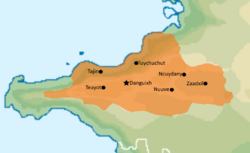Chik'in Kingdom

The Chik'in Kingdom, also known as the First Tullan, the Danguixh Hegemony, Puh, and very rarely referred as the Tatinak Kingdom, was a state located in the Mutul that existed between the third century BC to 304 AD when it became known as the Kuy Dynasty. It's capital was Danguixh, which grew to become one of the largest cities of its time with a population of 125,000 inhabitants intra muros.
Today, the Chik'in kingdom is famous for being the first "foreign" state to claim the mantle of Mutul and to unite both the west, center, and northern regions of the modern day Divine Kingdom. Many antiques and art works from its period have survived, and its influence continue to be felt to this day, having popularized religious figures such as the Feathered Serpent. Both its architectural styles and costumes would continue to be used in the Mutul for the following centuries of Kuy domination.
While it's end is officially placed in 304 AD, it was by all accounts a mere change of name, and the kingdom became the prestigious Kuy Dynasty which lived on for the next six centuries.
Etymology
Chik'in is an archaic Mutulese word for "West" used in Chaan Chronicles to refers to the areas including Danguixh and modern day Kanol. Tullan was the name used by the kingdom to refer to itself, a word of unspecified origin but with a meaning close to "Metropolis" or "Capital". This is translated in Mutuleses texts by the word Puh or "Place of Reeds".
The notion of "Kingdom" might be a misnomer inherited from the Chaan chronicles who didn't differentiate states by their political structures. Tullan-Puh might have been led by an oligarchy of military aristocrats and religious clerics as it lacks the archeological clues associated with a monarchic system. However it seems to have been de-facto led by the individual known as Jatz'om Kuy at the time of the conquest of the Mutul. It is possible that the system changed multiple times without the knowledge of the Chaan who didn't have direct contacts with "Puh" for most of their history, or that Jatz'om Kuy was a dictator-like figure who had consolidated all powers into his person. The lack of records from Tullan-Puh itself only impede our understanding of it's inner working.
History
Foundation
The early history of Tullan-Puh is quite mysterious and the origin of its founders is uncertain. Following Totonac legends, they and the Masipijni built it before the two peoples became distinct cultures. Archeological evidences points toward Danguixh fully formed after 300 BCE, following a series of catastrophic events, including a volcanic eruption and multiple years of droughts followed by floodings, that destroyed some of the largest settlements of the period in the Xizabi Valley.
The builders of the city took advantage of its environment. From the swampy ground, they constructed raised beds allowing for high agricultural productivity despite old methods of cultivation. This, in turn, formed channels, and subsequently canoe traffic, to transport food from farms around the city. By the first century BC, almost all of Tullan-Puh's greatest monuments had already been built.
Rise
Quickly, the population of the city greatly expanded and Tullan-Puh established many colonies all around the Xizabi Valley while other settlements were subdued. A generation later the metropolis had become the hegemon of the valley.
From there, signs of Tullan-Puh traders can be found in place far removed from the original city. It seems that they established permanent districts in all major urban centers of the period, including Yux, the capital of the Chaan Mutul. It's main export was obsidian tools and luxury goods, traded for salt, chocolate, rare feathers, and other highly sought-after materials. In parallel, the metropolis continued its expansionist policy, establishing colonies and outposts in strategic locations even outside of the Xizabi Valley, such as the cit of Tajin.
War with Ncuydany
While they at first the two expanding cities maintained friendly relations, including the installation of a Tullan-Puh trader district in Ncuydany, conflicts soon appeared over the control of key border regions. Ncuydany was the capital of a Be'e Naa state that also pursued an aggressive foreign policy and now wished to expand beyond its "traditional" area.
Tullan-Puh switched its alliances, abandoning its agreements with Ncuydany and allying with its rival : Zaadxil. This sparkled a series of wars that ended with the conquest of Ncuydany, an event witnessed by Mutuleses chroniclers whom had kept an eye on the rise of this neighboring state. Later on, Zaadxil would be officially given the status of "Tullan colony", meaning its citizens now shared the same privileges as those of Danguixh.
War with the Nuu Davi
The Nuu Davi king Teyusi Ñaña was the first monarch to ever unite the city-states of his people. He had been an important ally of Tullan-Puh in their wars against the Bee Naa but now his expansionism threatened Tullan's trade. He was in a position where he could cut the vital axis between Danguixh and Ncuydany in case of a conflict, and he regularly performed raids against Tullan traders to finance his state and as a show of strength. Punitive expeditions against him failed to change the situation.
In 51 BC, Teyusi managed to conquer one of the last Nuu Davi city to resist him and sacrificed almost the entirety of its ruling lineage if it wasn't for the youngest prince of the city managing to escape and find refuge in Tullan-Puh. Danguixh and this prince signed an official alliance and the latter managed to convince a number of Nuu Davi cities to rebel against Teyusi. With the support of Danguixh, Teyusi Nana was taken captive by the rebels and sacrificed. The entire Nuu Davi region then fell under Danguixh's control.

